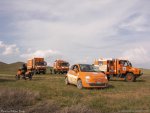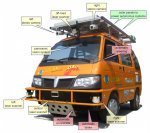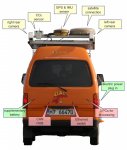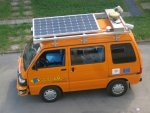.
CONTINUED FROM PREVIOUS POST
*****************************
5. What is the Meaning of “Third-World Capable”?
**********************************
In previous posts I've suggested that the
TerraLiner would be a
“Third World Capable” motorhome, and up until now this vague descriptor has served its purpose. But what is the “Third World”?
The term “Third World” was first coined in 1952, during the cold war, to describe the world's poorer countries that were “non-aligned”: neither members of the rich capitalist “First World”, as largely defined by NATO, nor members of the “Second World” of Soviet bloc and other communist countries – see
http://en.wikipedia.org/wiki/First_World ,
http://fifthworld.wikia.com/wiki/First_World ,
http://en.wikipedia.org/wiki/First_World_privilege ,
http://en.wikipedia.org/wiki/Second_World ,
http://fifthworld.wikia.com/wiki/Second_World ,
http://en.wikipedia.org/wiki/Third_World ,
http://fifthworld.wikia.com/wiki/Third_World , and
http://en.wikipedia.org/wiki/Three_Worlds_Theory . So from the very beginning, terms like “First World”, “Second World”, and “Third World” have mixed the economic with the political, generating much confusion.
For instance, in the following 1975 map China is colored red as “Second World”, because China was communist, as were Ethiopia and Vietnam. But in economic terms, in 1975 Vietnam, Ethiopia, and China were much poorer than the Soviet Union and east-Europe:

See
http://en.wikipedia.org/wiki/File:Cold_War_alliances_mid-1975.svg .
On this map Thailand and the Phillipines are also colored blue and “First World”, because they were staunch allies of the United States. But clearly, there was nothing “First World” about them, in economic terms.
Since the collapse of the Soviet Union and China's emergence as a “state-capitalist” or “market-Leninist” society, things have only gotten more confusing, to the point where many think we should abandon “Three Worlds Theory” and terminology altogether. So too, they will argue that the more simplistic “North/South” division is even worse – see for instance
http://www.geocurrents.info/economic-geography/there-is-no-third-world-there-is-no-global-south .
But terminology exists for a reason, because it helps us to make sense of the world – see
http://www.vagabondjourney.com/what-do-you-call-a-third-world-country/ . So my own inclination is to keep the terminology, but recast it along socio-economic lines. Doing so, however, proves controversial in practice, because even informed observers disagree about which countries should be classified as “First”, “Second”, and “Third”. So controversial, that Wikepedia held an online vote and debate to determine (in part) which map should be used for Wikepedia's article about the “Third World” – see
http://en.wikipedia.org/wiki/Talk:Third_World/countries_vote .
Personally, I am fond of the following five maps, and the fourth one in particular, because it captures the lingering ideological divide (China is still communist), while representing the economic dimension in a more discriminating way, dividing the planet into four worlds:





See
http://en.wikipedia.org/wiki/File:Third_world_countries_map_world_2.PNG ,
http://en.wikipedia.org/wiki/File:First_Second_and_Third_world_map_2007.jpg ,
http://fifthworld.wikia.com/wiki/File:UN_Human_Development_Report_2007.png ,
http://commons.wikimedia.org/wiki/File:UN_Human_Development_Report_2009.PNG , and
http://en.wikipedia.org/wiki/File:Worldmap-Worlds1234.png .
The second and third maps are also interesting, because they visibly capture the different levels of development in Latin America, for instance, where Brazil, Argentina, and Chile are better off than Peru, Bolivia, and Columbia. Or Panama and Costa Rica are more prosperous than Honduras and Nicaragua. And they capture the oil-fueled wealth of Muslim countries like Saudia Arabia and the Gulf states, in contrast to the comparative poverty of Muslim countries like Pakistan and Indonesia. But these maps also have their problems, because Thailand is now considerably more prosperous than neighboring Burma, Laos, and Cambodia; and Libya and Algeria are more prosperous than Morocco or Egypt.
The fifth map, which depicts countries as classified by the UN's HDI or “human development index” for 2009, is the most discriminating, and demonstrates something that well-travelled observers have long recognized: there is now a huge difference between "Third World” living conditions in most of central Africa, versus “Third World” living conditions in northern and southern Africa, South America, China, and Southeast Asia. The difference is now so large, that most of central Africa, along with countries like Myanmar and Laos, are best described as constituting a “Fourth World” of least developed countries – see
http://en.wikipedia.org/wiki/Fourth_World ,
http://fifthworld.wikia.com/wiki/Fourth_World , and
http://fifthworld.wikia.com/wiki/Least_Developed_Countries:

See
http://img2.wikia.nocookie.net/__cb...9/9b/Least_Developed_Countries_map_-_2006.png .
Yes, the term “Fourth World” is controversial, too, because originally it was coined to describe indigenous peoples....
 .
. But my own tendency is to now divide the planet along purely socio-economic lines, as follows:
 HDI dark Green -- the FIRST WORLD
HDI dark Green -- the FIRST WORLD
HDI medium, light green,. and light yellow .[and light yellow]
..--.the SECOND.WORLD .[WORLD]
HDI medium yellow and dark yellow -- the THIRD.WORLD
HDI orange, bright red, dark red, and black -- the FOURTH WORLD
On this line of thinking most of the Eurasian "north" is now Second World, economically speaking, including of course China, and so too most of Latin America.
One then strongly suspects that any global database of road conditions worldwide will tend to parallel the HDI world map. Driving in a "Second World", north-Eurasian country just will be very different from driving in Fourth-World Africa.
Put another way, there are underlying socio-economic reasons why
Overland 13 was able to travel with four Piaggio Porter electric-powered minivans across Eurasia, from Milan to Shanghai; and why a similar trip from Cairo to Cape would prove impossible. From Milan to Shanghai it was clear sailing across a swathe of HDI green. Whereas from Cairo to Cape one has to traverse a great deal of HDI orange and red, as became only too evident on
Overland 12. Central Africa is the least socio-economically developed region on earth, and so it should not surprise us that Central Africa also has the worst roads.
The question then becomes whether a
Terraliner should be designed with Central Africa in mind, or not. Should a
TerraLiner be "Fourth World Capable", and not merely "Third World Capable"?
In sum, I do not yet have a completely fixed idea what
“Third World Capable” should mean for the
TerraLiner. But if anyone reading this knows about a
“comparative compilation of road-conditions worldwide”, in print or online, that would be great place to start. And again, the key here is relative to vehicle type and size: a compilation that classifies roads worldwide as to their genuine suitability for motorbike, SUV, light-truck, medium truck, and heavy truck travel.
*****************************
CONTINUED IN NEXT POST
.



















































































